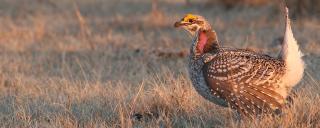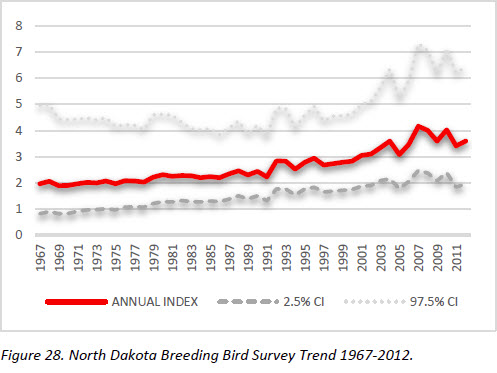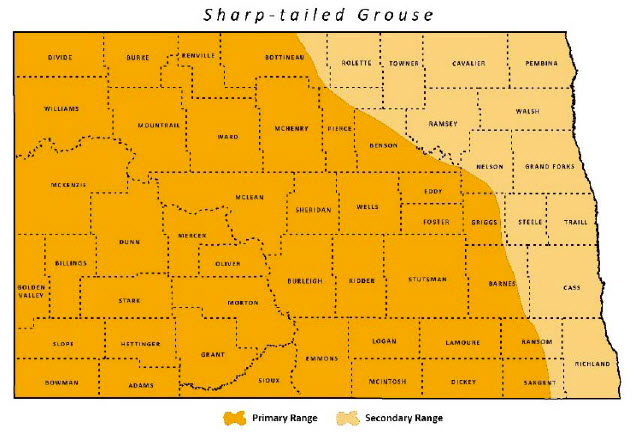
Sharp-tailed Grouse
| Scientific Name | Tympanuchus phasianellus |
|---|---|
| General Description | L 17”, WS 25”, 1.9lb. Light-colored overall with heavy dark barring on back, head, and wings. Also sports a pointed tail, yellow crest above the eye, and purple air sacs. |
| Status | Year-round resident. Peak breeding season April to July. |
| Abundance | Fairly common. |
| Primary Habitat | Mixed-grass prairie interspersed with shrubs. |
| Federal Status | None. |
| Reason for Designation | Although rather common in North Dakota, this species is showing a slight decrease in population rangewide. It is estimated as much as 1/3 of the entire population resides in the state, making North Dakota part of its core range. Partners in Flight (PIF) identifies the Sharp-tailed Grouse as a Regional Stewardship Species and a U.S.-Canada Stewardship Species. |
Video: sharp-tailed grouse dancing
Locations and Conditions of Key Habitat
Preferred Habitat
Sharp-tailed Grouse are most often found in relatively undisturbed mixed-grass prairie with patches of small trees and shrubs. CRP grasslands are also very important habitat for this species. Leks, or the dancing grounds used during the breeding season to attract mates, are typically located on elevated areas and are often characterized by less vegetation than the surrounding area. Nests are located fairly close, often within 0.5 mile, to then lek. Nest in lightly grazed native prairie, haylands, CRP, and may be located close to the margin of a thicket of shrubs or small trees. Switchgrass has been shown to provide an important habitat component in southeastern North Dakota. During winter grouse depend more on forested habitats, particularly during harsher winters. Feed primarily on buds, seeds, insects, fruits, and forbs.
Key Areas and Conditions for Sharp-tailed Grouse in North Dakota
Most common in the Missouri Slope region. Many leks have been identified throughout the state. These and the surrounding area (at a minimum, within 1 mile) should be of top priority for conservation.
Problems Which May Affect this Species
Habitat
Conversion of grassland to cropland, energy development and urban expansion. Degradation of grasslands from invasive plants, woody encroachment, succession, and loss of diversity. The expiration of CRP grasslands is also of concern and will result in population declines. Degradation due to livestock overuse can also reduce habitat quality.
Other Natural or Manmade Factors
Mortality such as birds flying into electric wires, fences, utility wires, and being hit by automobiles occur. Viewing grouse dancing on leks during the spring is a popular activity. Males appear more tolerant of this disturbance than females.
Research and Survey Efforts
Current Research or Surveys
- The North Dakota Game and Fish Department and several other federal and non-governmental organizations conduct annual lek surveys counting the number of birds present during the breeding season.
- The North Dakota Game and Fish Department and the University of North Dakota are evaluating the impacts of oil and gas development on Sharp-tailed Grouse.
Previous Research or Surveys
- Fair number of published reports and gray literature on the species throughout its range and in North Dakota.
Additional Research or Surveys Needed
Contact the North Dakota Game and Fish Department Upland Game Biologists for most current information needs.
Population and Trend Estimates

- PIF Global Population Estimate: 600,000
- PIF North American Population Estimate: 600,000
- PIF North Dakota Population Estimate: 170,000
- North Dakota BBS Trend: see figure 28
- Survey-wide BBS Trend 1966-2012: 0.33
Management Recommendations
- Protect leks and the surrounding habitat from loss or destruction.
- Plant a mixture of grasses and forbs when reclaiming cropland to grassland.
- Use rotational disturbance every 3-5 years, with prescribed burning as the preferred method.
- Develop grazing plans that provide residual vegetation for the following spring and eliminate over-utilization of woody draws, mesic swales and riparian areas.
- Control tall woody vegetation.
- Delay cutting from April 15 – August 1, and use a stripper header and flushing bars. When cutting, leave the highest possible height (12-24 inches).
- Conscientious use of pesticides.
- Avoid constructing fences through or near leks and install visibility markers to existing fences.
- Utility development should follow the guidance of “Reducing Avian Collisions with Power Lines” including marking power lines and creating an Avian Protection Plan.
Monitoring Plans
According to the Partners in Flight Landbird Conservation Plan, long-term population trend monitoring such as the Breeding Bird Survey produces imprecise trends for this species. No additional monitoring is needed at this time as the NDGFD will continue in the lead role of obtaining population date on Sharp-tailed Grouse.
2005-2015 Progress
The Sharp-tailed Grouse remains a Level I Species of Conservation Priority. Several State Wildlife Grant Projects (T2-11-HM, T-18-R, T-20-D, T-21-D, T-22-HM, T-23-HM, T-25-HM, T-28-L, T-37-D) have contributed to habitat enhancement grasslands for Sharp-tailed Grouse and other grassland dependent birds.

Note: A listing of works consulted when compiling the information on this page may be found in the 2015 State Wildlife Action Plan.
